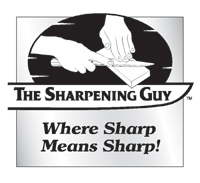- If you want to keep your knife sharper for longer in between sharpenings I recommend using a honing rod for most knives. If you have a Japanese knife, then I recommend using Japanese water stones. Click here for instructions on how to use a honing rod or Japanese waterstones.
- Only use a wood or a soft plastic cutting board. Never use glass, ceramic, marble, or steel cutting boards because they will damage the cutting edge of your knife.
- When you clean your knife, do not to allow the cutting edge of your blade to touch your sink. There are a couple of ways to accomplish this. One way is to dip the knife in the water and wash it without allowing it to touch the sink. The second way is to lay the cutting board on the edge of your sink so that the cutting board is sitting diagonally in your sink. Now you may hold the knife against the cutting board while you are washing the knife. This will protect the edge of you knife from being damaged by touching your sink.
- When you dry off a knife, you should fold a towel over the spine (opposite the cutting edge) of the knife. Next you pinch the towel over the sides of the knife and carefully pull the knife through. Never fold a towel over the cutting edge of your knife.
- Do not put your knife in the sink, in the dishwasher, or loose in a drawer. Any time that your blade comes in contact with something harder than the blade, it damages the cutting edge.
- Always store your knife with the blade protected from bumping into anything.
- If your knife has a carbon steel blade, then you may want to keep your blade lightly coated with camellia oil.
- (616) 364-0941 - texting preferred
- info@thesharpeningguy.com
